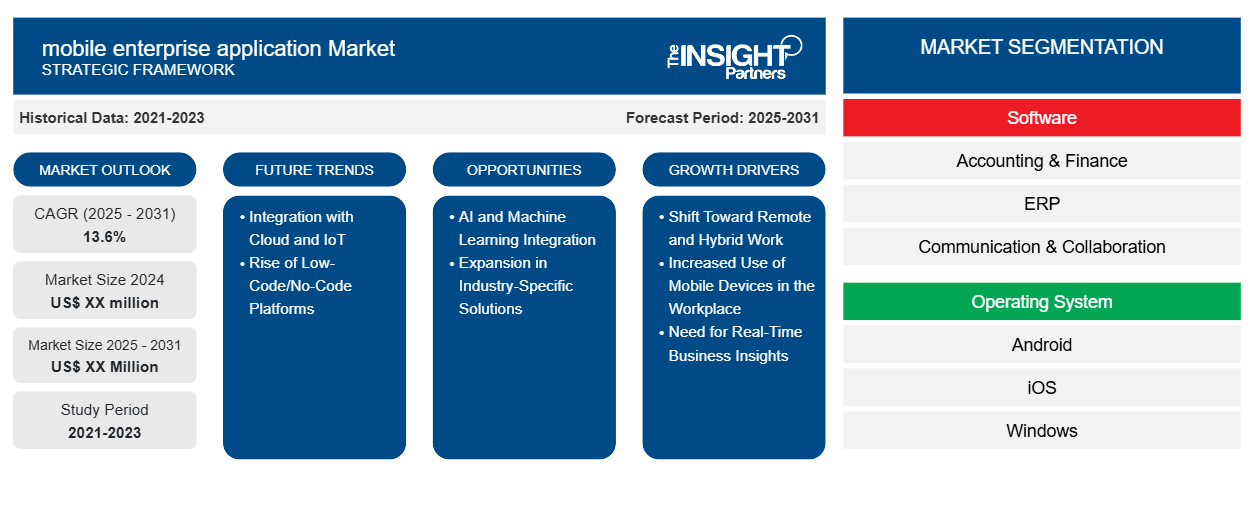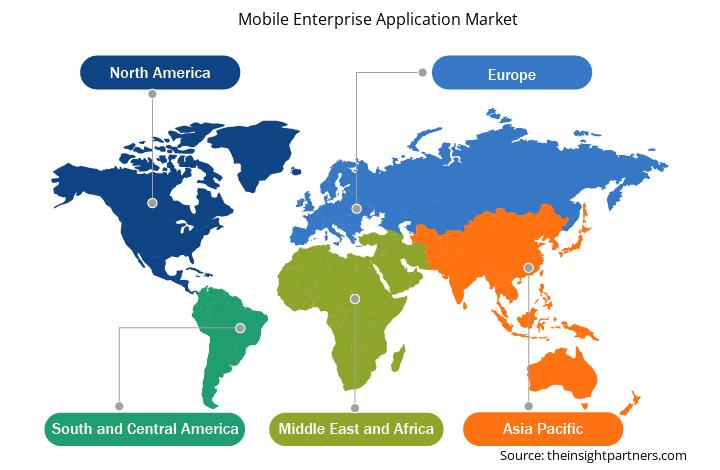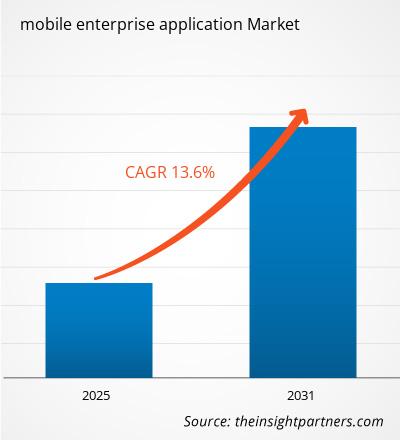Le marché des applications mobiles d'entreprise devrait enregistrer un TCAC de 13,6 % de 2025 à 2031, avec une taille de marché passant de XX millions de dollars américains en 2024 à XX millions de dollars américains d'ici 2031.
Le rapport est segmenté par logiciel (comptabilité et finance, ERP, communication et collaboration, et CRM), système d'exploitation (Android, iOS et Windows), type d'application (native, hybride, web) et utilisateur final (BFSI, administration publique, médias et divertissement, transport et logistique, commerce de détail, santé et sciences de la vie, éducation, industrie et automobile, autres). L'analyse mondiale est ensuite détaillée par région et par principaux pays. Le rapport présente la valeur en USD pour l'analyse et les segments ci-dessus.
Objet du rapport
Le rapport sur le marché des applications mobiles d'entreprise, publié par The Insight Partners, vise à décrire le paysage actuel et la croissance future, ainsi que les principaux moteurs, défis et opportunités. Il fournira des informations aux différents acteurs de l'entreprise, notamment :
- Fournisseurs/fabricants de technologies : pour comprendre l’évolution de la dynamique du marché et connaître les opportunités de croissance potentielles, leur permettant de prendre des décisions stratégiques éclairées.
- Investisseurs : réaliser une analyse complète des tendances concernant le taux de croissance du marché, les projections financières du marché et les opportunités qui existent tout au long de la chaîne de valeur.
- Organismes de réglementation : Réglementer les politiques et les activités de police sur le marché dans le but de minimiser les abus, de préserver la confiance des investisseurs et de maintenir l’intégrité et la stabilité du marché.
Segmentation du marché des applications mobiles d'entreprise
Logiciel
- Comptabilité et finances
- ERP
- Communication et collaboration
- CRM
Système opérateur
- Androïde
- iOS
- Windows
Type d'application
- Indigène
- Hybride
- Web
Utilisateur final
- BFSI
- Gouvernement
- Médias et divertissement
- Transport et logistique
- Vente au détail
- Santé et sciences de la vie
- Éducation
- Industrie manufacturière et automobile
Personnalisez ce rapport en fonction de vos besoins
Vous bénéficierez d'une personnalisation gratuite de n'importe quel rapport, y compris des parties de ce rapport, ou d'une analyse au niveau des pays, d'un pack de données Excel, ainsi que de superbes offres et réductions pour les start-ups et les universités.
Marché des applications mobiles d'entreprise : perspectives stratégiques

- Obtenez les principales tendances clés du marché de ce rapport.Cet échantillon GRATUIT comprendra une analyse de données, allant des tendances du marché aux estimations et prévisions.
Moteurs de croissance du marché des applications mobiles d'entreprise
- Transition vers le télétravail et le travail hybride : La tendance croissante au télétravail et au travail hybride a incité les entreprises à adopter des applications mobiles. Ces applications permettent aux employés d'accéder aux outils et ressources professionnels où qu'ils soient, améliorant ainsi la productivité et la collaboration, ce qui est particulièrement crucial pour les entreprises opérant à l'international ou avec des équipes dispersées.
- Utilisation croissante des appareils mobiles au travail : L'utilisation généralisée des smartphones et des tablettes au travail accélère le développement du marché des applications mobiles d'entreprise. Ces appareils deviennent essentiels pour permettre aux employés d'accéder aux ressources de l'entreprise, de gérer leurs tâches et de communiquer en déplacement, ce qui incite les organisations à investir dans des solutions mobiles personnalisées pour optimiser leurs flux de travail.
- Besoin d'informations commerciales en temps réel : Les entreprises ont besoin de données et d'analyses en temps réel pour prendre rapidement des décisions éclairées. Les applications mobiles d'entreprise permettent aux managers et aux employés d'accéder à des informations commerciales et à des indicateurs de performance actualisés, ce qui les rend essentielles pour optimiser les processus décisionnels et l'efficacité opérationnelle dans des environnements commerciaux dynamiques.
Tendances futures du marché des applications mobiles d'entreprise
- Intégration au cloud et à l'IoT : Les applications mobiles d'entreprise s'intègrent de plus en plus aux plateformes cloud et aux objets connectés (IoT) pour offrir un accès aux données en temps réel et une collaboration fluide. Cette tendance permet aux entreprises d'améliorer leur efficacité opérationnelle en permettant un flux continu d'informations entre les applications mobiles, les outils cloud et les objets connectés.
- Essor des plateformes low-code/no-code : L'adoption croissante de plateformes de développement low-code/no-code permet aux entreprises de créer et de déployer rapidement des applications mobiles d'entreprise sans nécessiter de compétences approfondies en codage. Cette tendance permet aux utilisateurs non techniques de personnaliser et de créer des applications adaptées à leurs besoins métier spécifiques, réduisant ainsi les délais et les coûts de développement.
Opportunités de marché des applications mobiles d'entreprise
- Intégration de l'IA et du Machine Learning : Avec l'évolution des technologies d'IA et de Machine Learning, l'intégration de ces capacités aux applications mobiles d'entreprise offrira de nouvelles opportunités. Les applications mobiles peuvent utiliser l'IA pour automatiser les tâches, améliorer la prise de décision, offrir des expériences utilisateur personnalisées et optimiser les processus métier, offrant ainsi aux organisations de nouveaux gains d'efficacité.
- Développement de solutions sectorielles : Le développement d'applications mobiles d'entreprise adaptées à des secteurs spécifiques comme la santé, l'industrie manufacturière, la vente au détail et la logistique offre d'importantes opportunités. Des solutions personnalisées peuvent répondre aux besoins spécifiques de chaque secteur, tels que la conformité réglementaire, la gestion de la chaîne d'approvisionnement ou les soins aux patients, favorisant ainsi une adoption croissante dans tous les secteurs.
Aperçu régional du marché des applications mobiles d'entreprise
Les analystes d'Insight Partners ont analysé en détail les tendances et les facteurs régionaux influençant le marché des applications mobiles d'entreprise au cours de la période de prévision. Cette section aborde également les segments et la répartition géographique du marché des applications mobiles d'entreprise en Amérique du Nord, en Europe, en Asie-Pacifique, au Moyen-Orient et en Afrique, ainsi qu'en Amérique du Sud et en Amérique centrale.

- Obtenez les données régionales spécifiques au marché des applications mobiles d'entreprise
Portée du rapport sur le marché des applications mobiles d'entreprise
| Attribut de rapport | Détails |
|---|---|
| Taille du marché en 2024 | XX millions de dollars américains |
| Taille du marché d'ici 2031 | XX millions de dollars américains |
| TCAC mondial (2025 - 2031) | 13,6% |
| Données historiques | 2021-2023 |
| Période de prévision | 2025-2031 |
| Segments couverts | Par logiciel
|
| Régions et pays couverts | Amérique du Nord
|
| Leaders du marché et profils d'entreprises clés |
|
Densité des acteurs du marché des applications mobiles d'entreprise : comprendre son impact sur la dynamique des entreprises
Le marché des applications mobiles d'entreprise connaît une croissance rapide, portée par une demande croissante des utilisateurs finaux, liée à l'évolution des préférences des consommateurs, aux avancées technologiques et à une meilleure connaissance des avantages du produit. Face à cette demande croissante, les entreprises élargissent leur offre, innovent pour répondre aux besoins des consommateurs et capitalisent sur les nouvelles tendances, ce qui alimente la croissance du marché.
La densité des acteurs du marché désigne la répartition des entreprises opérant sur un marché ou un secteur particulier. Elle indique le nombre de concurrents (acteurs) présents sur un marché donné par rapport à sa taille ou à sa valeur marchande totale.
Les principales entreprises opérant sur le marché des applications mobiles d'entreprise sont :
- AT&T
- IBM Corporation
- BlackBerry Limited
- Services de conseil Tata
- Infosys Limited
- SAP SE
Avertissement : Les entreprises répertoriées ci-dessus ne sont pas classées dans un ordre particulier.

- Obtenez l'aperçu des principaux acteurs du marché des applications mobiles d'entreprise
Principaux arguments de vente
- Couverture complète : Le rapport couvre de manière exhaustive l'analyse des produits, des services, des types et des utilisateurs finaux du marché des applications d'entreprise mobiles, offrant un paysage holistique.
- Analyse d’experts : Le rapport est compilé sur la base d’une compréhension approfondie des experts et analystes du secteur.
- Informations à jour : Le rapport garantit la pertinence commerciale en raison de sa couverture des informations récentes et des tendances des données.
- Options de personnalisation : ce rapport peut être personnalisé pour répondre aux exigences spécifiques des clients et s'adapter de manière appropriée aux stratégies commerciales.
Le rapport de recherche sur le marché des applications mobiles d'entreprise peut donc contribuer à éclairer et à comprendre le contexte et les perspectives de croissance du secteur. Malgré quelques inquiétudes légitimes, les avantages globaux de ce rapport l'emportent généralement sur les inconvénients.
- Analyse historique (2 ans), année de base, prévision (7 ans) avec TCAC
- Analyse PEST et SWOT
- Taille du marché Valeur / Volume - Mondial, Régional, Pays
- Industrie et paysage concurrentiel
- Ensemble de données Excel
Rapports récents
Rapports connexes
Témoignages
Raison d'acheter
- Prise de décision éclairée
- Compréhension de la dynamique du marché
- Analyse concurrentielle
- Connaissances clients
- Prévisions de marché
- Atténuation des risques
- Planification stratégique
- Justification des investissements
- Identification des marchés émergents
- Amélioration des stratégies marketing
- Amélioration de l'efficacité opérationnelle
- Alignement sur les tendances réglementaires




















 Obtenez un échantillon gratuit pour - marché des applications mobiles d'entreprise
Obtenez un échantillon gratuit pour - marché des applications mobiles d'entreprise